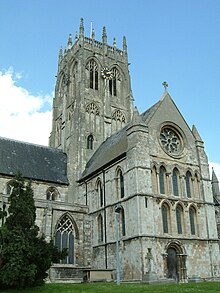
Howden Minster is a large Grade I listed Church of England church in the Diocese of York. It is located in Howden, East Riding of Yorkshire, England and is one of the largest churches in the East Riding. It is dedicated to St Peter and St Paul and it is therefore properly known as 'the Minster Church of St Peter and St Paul'. Its Grade I listed status also includes the Chapter House.

All Saints' Church is an ecumenical church located in Loughton, Milton Keynes, England.

St Patrick's Church, Patrington is an Anglican parish church located in Patrington, East Riding of Yorkshire, England. The church is a Grade I listed building.

St John the Baptist's Church is in the village of Pilling, Lancashire, England. It is an active Anglican parish church in the deanery of Garstang, the archdeaconry of Lancaster and the diocese of Blackburn. The church is recorded in the National Heritage List for England as a designated Grade II* listed building. Its benefice is combined with those of St James, Stalmine, and St Mark, Eagland Hill. It is described as "a fine example of the late Gothic Revival church with much originality in detail".

All Souls Church, Halifax, is a redundant Anglican church in Haley Hill, Halifax, West Yorkshire, England. It is recorded in the National Heritage List for England as a designated Grade I listed building, and is under the care of the Churches Conservation Trust. The church is open to visitors at limited times.

St Andrew's Church is a redundant Anglican church in Cranford St Andrew, Northamptonshire, England. It is recorded in the National Heritage List for England as a designated Grade II* listed building, and is under the care of the Churches Conservation Trust. The church stands in the park of Cranford Hall, to the southwest of the house.

St Mary the Virgin's Church is a redundant Anglican church in the civil parish of Wiggenhall St Germans, Norfolk, England. It is recorded in the National Heritage List for England as a designated Grade I listed building, and is under the care of the Churches Conservation Trust. The church stands at the end of a lane to the north of the village of Wiggenhall St Mary the Virgin, some 5 miles (8 km) south of King's Lynn. It is notable particularly for the quality of carving of its wooden fittings.

St John and All Saints' Church is in the town of Easingwold. North Yorkshire, England. It is an active Anglican parish church in the deanery of Easingwold, the archdeaconry of York, and the diocese of York. Its benefice is united with that of St Mary, Raskelf. The church is recorded in the National Heritage List for England as a designated Grade II* listed building.

St John the Evangelist's Church is in the village of Crawshawbooth, near Rawtenstall, Lancashire, England. It is a redundant Anglican parish church formerly in the deanery of Rossendale, the archdeaconry of Bolton, and the diocese of Manchester. Its benefice has been united with that of St Mary and All Saints, Goodshaw. The church is recorded in the National Heritage List for England as a designated Grade II* listed building.

St John the Divine Church is in Draycombe Drive, Sandylands, Morecambe, Lancashire, England. It is an active Anglican parish church in the deanery of Lancaster and Morecambe, the archdeaconry of Lancaster, and the diocese of Blackburn. The church is recorded in the National Heritage List for England as a designated Grade II listed building.

St Peter's and St Paul's Church is a parish church in Headcorn, Kent dedicated to saints Peter and Paul. It was begun in the 13th century. The church is a Grade I listed building.

All Saints is a parish church in Ulcombe, Kent. It was begun in the 12th century and is a Grade I listed building.

St Peter's and St Paul's Church is a parish church in Yalding, Kent, dedicated to saints Peter and Paul. It was begun in the 13th century and is a Grade I listed building.

The church of St Mary the Virgin is an Anglican parish church in the village of Hanbury, Worcestershire. Its earliest parts date from about 1210 and it is a Grade I listed building. The church was the family church for the Vernon family of nearby Hanbury Hall.

St John the Evangelist's Church is in Fountains Road, Kirkdale, Liverpool, Merseyside, England. It is an active Roman Catholic parish church in Pastoral Area of Liverpool North, in the Archdiocese of Liverpool. The church is recorded in the National Heritage List for England as a designated Grade II listed building.

The second St Mary's Roman Catholic Church is a heritage-listed sandstone Catholic church at 163 Palmerin Street in Warwick in the Southern Downs Region, Queensland, Australia. It was designed by Dornbusch & Connolly and built from 1920 to 1926. It is also known as St Mary of the Assumption Church. It was added to the Queensland Heritage Register on 21 October 1992.

St Vincent's Church is a Grade I listed Church of England parish church in Caythorpe, Lincolnshire, England. It is at the southern edge of the Lincoln Cliff in South Kesteven, and 10 miles (16 km) north from Grantham.

St James the Great Church is a Grade I listed Church of England parish church dedicated to James, son of Zebedee in Aslackby, Lincolnshire, England. The church is 7 miles (11 km) north from Bourne, and in the Aslackby and Laughton parish on the eastern edge the South Kesteven Lincolnshire Vales.

St Mary's Church is an Anglican parish church in the English village of Welwick in the East Riding of Yorkshire. It is a Grade I listed building.

St Margaret's Church is a 13th-century Church of England church in the village of Whaddon, Gloucestershire, England. It has been a grade II* listed building since 10 January 1955. The church tower is a dominant feature within the surrounding flat area.






















